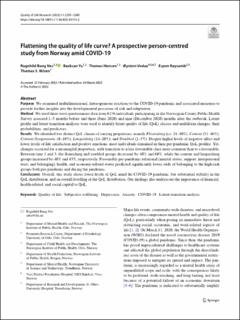| dc.description.abstract | Purpose
We examined multidimensional, heterogeneous reactions to the COVID-19 pandemic and associated measures to provide further insights into the developmental processes of risk and adaptation.
Method
We used three-wave questionnaire data from 8156 individuals participating in the Norwegian County Public Health Survey assessed 1–5 months before and three (June 2020) and nine (December 2020) months after the outbreak. Latent profile and latent transition analyses were used to identify latent quality of life (QoL) classes and multiform changes, their probabilities, and predictors.
Results
We identified five distinct QoL classes of varying proportions, namely Flourishing (i.e. 24–40%), Content (31–46%), Content-Symptomatic (8–10%), Languishing (14–20%), and Troubled (2–5%). Despite higher levels of negative affect and lower levels of life satisfaction and positive emotions, most individuals remained in their pre-pandemic QoL profiles. Yet, changes occurred for a meaningful proportion, with transition to a less favourable class more common than to a favourable. Between time 1 and 3, the flourishing and troubled groups decreased by 40% and 60%, while the content and languishing groups increased by 48% and 43%, respectively. Favourable pre-pandemic relational (marital status, support, interpersonal trust, and belonging), health, and economy-related status predicted significantly lower odds of belonging to the high-risk groups both pre-pandemic and during the pandemic.
Conclusions
Overall, this study shows lower levels of QoL amid the COVID-19 pandemic, but substantial stability in the QoL distribution, and an overall levelling of the QoL distribution. Our findings also underscore the importance of financial, health-related, and social capital to QoL. | en_US |

